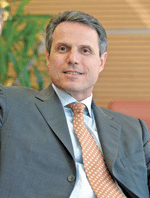2010 was a year of records setting for STMicroelectronics. The company clocked revenues of $10.35 billion–the highest annual sales in its history. It was also a great year for the full range of its ‘sense and power’ portfolio (advanced analogue and MEMS, as well as microcontrollers and automotive applications).
Carlo Bozotti, president and chief executive officer of STMicroelectronics, was recently in India at the Greater Noida campus of the company to share the achievements. On the occasion, he spoke to Uma Bansal, executive editor at EFY, on semiconductor industry trends and ST’s contribution. Excerpts:

APRIL 2011: Semiconductors are today at the heart of many exciting applications. What applications do you see as the most promising?
We are targeting four major application areas: Smart consumer devices (portable devices, home appliances, tablets to HDTV, etc), energy management and saving, healthcare and wellness, and trust and data security.
What are the key technology trends driving the semiconductor space globally?
From silicon technology point of view, there are two major blocks. One is continuation of Moore’s Law. It’s basically doubling the number of transistors per square millimetre every 18 months. This is still valid for all the VLSI technologies, and continues to be a strong and very important driver. Then there is the second block of technologies which we define as ‘more than Moore.’ Here the evolution is not just in terms of the number of transistors or other things on the chip area but in terms of special functionalities like micro-machinery techniques and smart power techniques for power products, new materials like silicon carbide (SiC) and gallium nitride (GaN), or 3D integration.
Around these two blocks of technologies is the application aspect. An important trend we see today is that for more and more applications, we need to provide our customers complete solutions, not just products.
For portable devices, power consumption is very important. What’s the industry doing to reduce power consumption by chips?
We are continuously innovating in terms of technology to reduce the consumption of power in silicon and new materials like SiC. Also, there is a continuous drive to improve the topology or configuration of power applications to consume less energy. And then there is the trend to exploit fusion of alternative energies. Take solar energy, for instance. We have developed a micro inverter for solar cell solutions that is particularly intended to optimise the power efficiency of solar cells. In this frame, we have developed a single-chip solution that is kind of power tracking solution to really optimise the efficiency at the level of one cell, excluding areas of the cell that aren’t well exposed to the sun, for instance, and boosting of the rest.
There are many things that you can do; for instance, in automotives, to start and stop, or vice versa in the city. It happened to me when I was in the gulf a few days ago. A car automatically stopped on approaching the traffic light. This is another example of fuel consumption reduction.
Coming to ST, how much you value innovation while designing?
We have taken many initiatives at ST to boost innovation. For instance, we have a specific organisation that we call Advanced System Technology that works on future trends just to explore new opportunities and new ideas for innovation. Every year, we meet with the council of well-known professors from universities to benchmark what we do. We have innovation circles in many sites where we operate to boost innovation. We have a corporate initiative called cross-functional initiative that we define as R&D excellence. This cross-functioning initiative again is to boost the effectiveness of what we do in R&D and therefore to boost innovation. The objective is to be more innovative and drive radical innovation.
How important is it for you to have design centre in India?
The quantity of what we do here is as important as the quality of what we do here. Here the market is becoming very significant and therefore we need to be present developing products for the Indian market also.
We have 2200 people in our Greater Noida and Bengaluru centres. And I think we are one of the biggest in the semiconductor arena in India. We are working on many important programmes not only for digital consumer and computer peripheral applications but also for automotives where we are working on advanced 32nm technology line powertrain. We are working on powertrain, entertainment and navigation chips. ST India contributes 15 to 20 per cent of the overall design portfolio of the company.
What are the three key areas of growth here?
The three key areas of growth are digital consumers (combination of set-top box and digital TV), power (lighting and electronic metering), and security (identification and trust using secure microcontrollers, smart cards, ID cards, etc).






